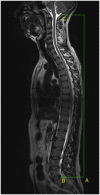Intervertebral Disc Swelling Demonstrated by 3D and Water Content Magnetic Resonance Analyses after a 3-Day Dry Immersion Simulating Microgravity
- PMID: 27994557
- PMCID: PMC5136574
- DOI: 10.3389/fphys.2016.00605
Intervertebral Disc Swelling Demonstrated by 3D and Water Content Magnetic Resonance Analyses after a 3-Day Dry Immersion Simulating Microgravity
Abstract
Background: Vertebral deconditioning is commonly experienced after space flight and simulation studies. Disc herniation is quadrupled after space flight. Purpose: The main hypothesis formulated by the authors is that microgravity results in intervertebral disc (IVD) swelling. Study Design: The aim of the study was to identify the morphological changes of the spine and their clinical consequences after simulated microgravity by 3-day dry immersion (DI). The experimental protocol was performed on 12 male volunteers using magnetic resonance imaging and spectroscopy before and after DI. Methods: All the experiment was financially supported by CNES (Centre national d'études spatiales i.e., French Space Agency). Results: We observed an increase in spine height of 1.5 ± 0.4 cm and a decrease in curvature, particularly for the lumbar region with a decrease of -4 ± 2.5°. We found a significant increase in IVD volume of +8 ± 9% at T12-L1 and +11 ± 9% at L5-S1. This phenomenon is likely associated with the increase in disc intervertebral water content (IWC), 17 ± 27%. During the 3 days in DI, 92% of the subjects developed back pain in the lumbar region below the diaphragmatic muscle. This clinical observation may be linked to the morphological changes of the spine. Conclusions: The morphological changes observed and, specifically, the disc swelling caused by increased IWC may contribute to understanding disc herniation after microgravity exposure. Our results confirmed the efficiency of the 3-day DI model to reproduce quickly the effects of microgravity on spine morphology. Our findings raise the question of the subject selection in spatial studies, especially studies about spine morphology and reconditioning programs after space flight. These results may contribute to a better understanding of the mechanisms underlying disc herniation and may serve as the basis to develop countermeasures for astronauts and to prevent IVD herniation and back pain on Earth.
Keywords: back pain; disc herniation; disc swelling; dry immersion; magnetic resonance imaging/magnetic resonance spectroscopy; microgravity; vertebral deconditioning.
Figures








Similar articles
-
From the international space station to the clinic: how prolonged unloading may disrupt lumbar spine stability.Spine J. 2018 Jan;18(1):7-14. doi: 10.1016/j.spinee.2017.08.261. Epub 2017 Sep 28. Spine J. 2018. PMID: 28962911 Free PMC article.
-
DI-5-Cuffs: Lumbar Intervertebral Disc Proteoglycan and Water Content Changes in Humans after Five Days of Dry Immersion to Simulate Microgravity.Int J Mol Sci. 2020 May 26;21(11):3748. doi: 10.3390/ijms21113748. Int J Mol Sci. 2020. PMID: 32466473 Free PMC article. Clinical Trial.
-
Biomechanical changes in the lumbar spine following spaceflight and factors associated with postspaceflight disc herniation.Spine J. 2022 Feb;22(2):197-206. doi: 10.1016/j.spinee.2021.07.021. Epub 2021 Jul 31. Spine J. 2022. PMID: 34343665
-
Neurosurgery and spinal adaptations in spaceflight: A literature review.Clin Neurol Neurosurg. 2021 Aug;207:106755. doi: 10.1016/j.clineuro.2021.106755. Epub 2021 Jun 8. Clin Neurol Neurosurg. 2021. PMID: 34126454 Review.
-
Low Back Pain During and After Spaceflight: A Systematic Review with Meta-Analysis.J Pain Res. 2024 Dec 6;17:4103-4139. doi: 10.2147/JPR.S491060. eCollection 2024. J Pain Res. 2024. PMID: 39660277 Free PMC article. Review.
Cited by
-
Multi-System Deconditioning in 3-Day Dry Immersion without Daily Raise.Front Physiol. 2017 Oct 13;8:799. doi: 10.3389/fphys.2017.00799. eCollection 2017. Front Physiol. 2017. PMID: 29081752 Free PMC article.
-
Short-term disuse promotes fatty acid infiltration into skeletal muscle.J Cachexia Sarcopenia Muscle. 2018 Apr;9(2):335-347. doi: 10.1002/jcsm.12259. Epub 2017 Dec 16. J Cachexia Sarcopenia Muscle. 2018. PMID: 29248005 Free PMC article.
-
Dry Immersion as a Ground-Based Model of Microgravity Physiological Effects.Front Physiol. 2019 Mar 27;10:284. doi: 10.3389/fphys.2019.00284. eCollection 2019. Front Physiol. 2019. PMID: 30971938 Free PMC article. Review.
-
Does Physical Inactivity Induce Significant Changes in Human Gut Microbiota? New Answers Using the Dry Immersion Hypoactivity Model.Nutrients. 2021 Oct 29;13(11):3865. doi: 10.3390/nu13113865. Nutrients. 2021. PMID: 34836120 Free PMC article. Clinical Trial.
-
Pain and Vertebral Dysfunction in Dry Immersion: A Model of Microgravity Simulation Different from Bed Rest Studies.Pain Res Manag. 2017;2017:9602131. doi: 10.1155/2017/9602131. Epub 2017 Jul 13. Pain Res Manag. 2017. PMID: 28785161 Free PMC article.
References
-
- Andersson G. B., Murphy R. W., Ortengren R., Nachemson A. L. (1979). The influence of backrest inclination and lumbar support on lumbar lordosis. Spine 4, 52–58. - PubMed
LinkOut - more resources
Full Text Sources
Other Literature Sources

